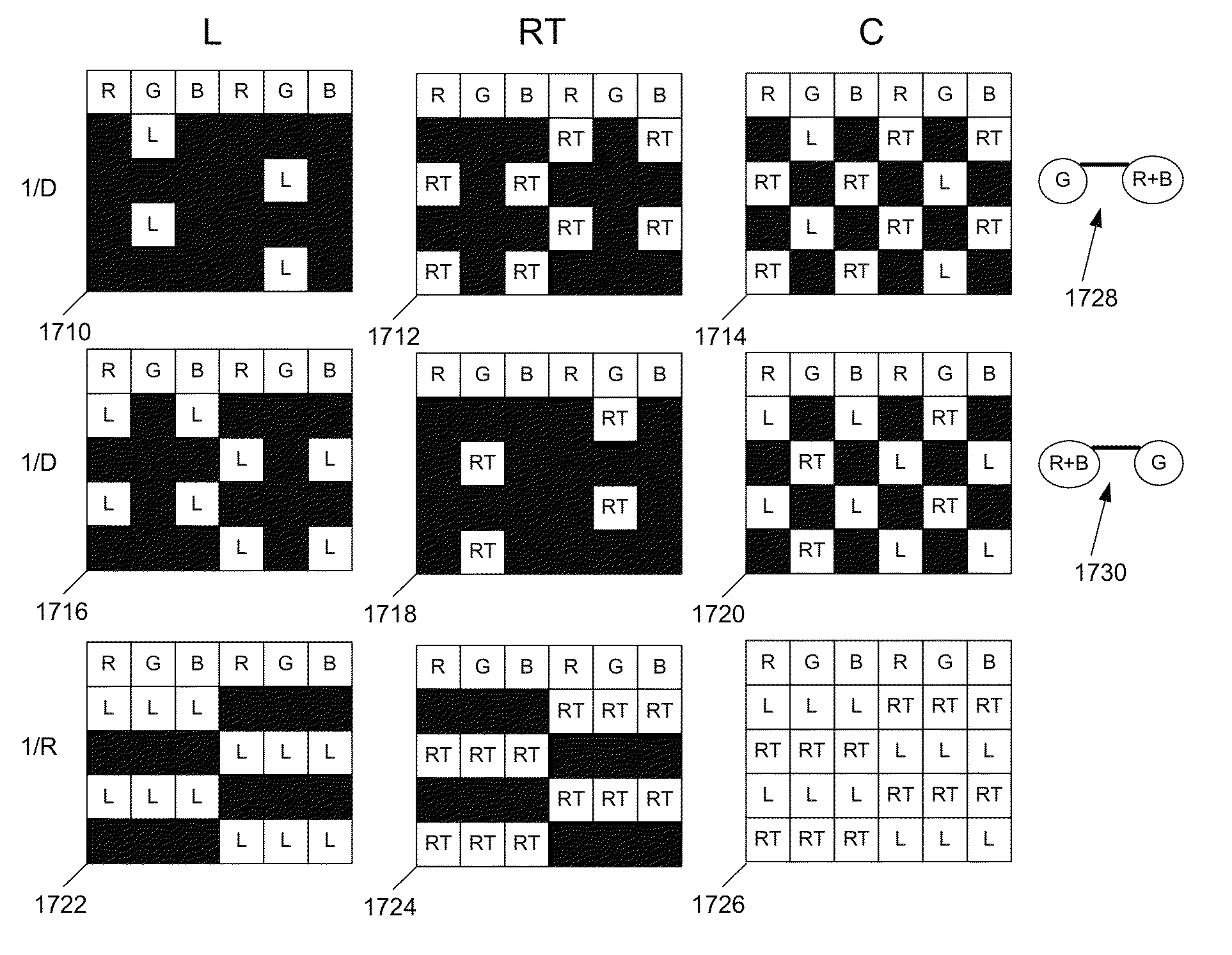However, none of them have succeeded in overcoming all obstacles regarding required quality, simplicity, practicality, and affordability to enable any of them to be accepted by the marketplace and become the standard for
consumer stereoscopic 3-D television.
Anaglyphic (and other color-separation) glasses-viewed displays, still in use today, fail to provide natural color imagery and usually produce
eyestrain and
headaches after a relatively short period of time.
This is due to color rivalry and brightness imbalance between the images supplied to the two eyes of the viewers.
In addition, the difficulty in providing filters that match the colors emitted by TV sets and efficiently separate the images by their color, due to the overlapping spectra of TV phosphors or filters, causes
ghosting that reduces the 3-D effect, blurs image elements in front of, and behind, the
image plane, and provides an annoying experience.
Perpendicular dual displays are expensive, bulky, and ugly.
In addition, the full-screen
image resolution is divided by the number of images being shown at different angles, dramatically reducing the resolution of each image.
In addition, due to image
crosstalk, two or more images can always be seen at the same time, causing
ghosting and blurring of image elements appearing too far in front of, or behind, the
image plane.
This limits the amount of depth that can be shown with this technology.
Parallax barrier displays have the same drawbacks as lenticular displays, with the added drawback that they produce a
dimmer image.
The combination of polarized color
multiplexing with micro-
polarizer technology utilizes a
complex system requiring special cameras and either an expensive complex series of large (as big as the entire display) electro-optical (pi-
cell) panels, or, alternately, an expensive, complex, never-before-tried cholesteric micro-
polarizer filter screen installed in front of a display.
As of the filing date of this application there is no compression and
transmission system capable of providing the ability to
encode stereoscopic image pairs over a single TV channel wherein each image of the
stereo pair is transmitted with full high-definition resolution while enough unique (representing different points in time) stereo pairs are transmitted per second to provide the full standard video
frame rate for each eye.
Nor is there a way to display stereoscopic image pairs on readily available TV monitors wherein each image of the
stereo pair is displayed with full high-definition resolution while enough unique (representing different points in time) stereo pairs are displayed per second to provide the full standard video
frame rate for each eye.
In other words, the current HDTV standard does not support the amount of information required to transmit and display two images needed for 3-D at the maximum resolution and
frame rate for both required stereoscopic images.
The
shutter glasses are not inexpensive (currently being sold for $150 each) and produce the appearance of some noticeable
flicker (especially in
peripheral vision), since each eye alternately switches from total black to total image brightness, giving the
flicker the highest possible contrast and
visibility.
However, even with monitors operating at 120 Hz, the rods in many people's eyes (which make up 125 million of the 130 million receptors of each eye and which are found predominantly in the periphery of the retinas) can still detect the
flicker, which is annoying and can create
eyestrain and
headaches after a period of time.
Currently, while this
system is becoming popular in Europe, the US has very limited sales.
Even though the alternate-line
system produces less
ghosting than the alternate-frame system, the increased profit margin on sales of
shutter glasses has resulted in this imbalance in sales volumes of the two systems.
It also introduces
jaggies, creating image artifacts, and eliminates fine detail, often making small, originally readable text unreadable.
Another drawback of the alternate line system is that the micro-
polarizer is attached to the outside surface of the LCD, thereby being spaced a distance away (the thickness of the LCD glass) from the actual pixels.
Consequently, there is a limited vertical viewing angle (you can't stand up or lie on the floor when viewing this display), beyond which
parallax error (between pixels and micro-polarizers) causes both images to be seen by each eye, eliminating the 3-D and creating an annoying double image.
As stated above, since the micro-polarizers are mounted on the outside of the glass surface of the monitor, while the liquid crystals which form the image are on the opposite side of the glass, a
parallax error is created, producing a limited
vertical angle of view.
All systems suffer from the fact that, to display a stereoscopic image, two images must simultaneously be transmitted and displayed over a single
television channel, which is only large enough for one image.
Consequently, displaying the two images to create stereoscopic viewing reduces the overall information content (resolution or motion smoothness of each eye's image) by 50% (although time-multiplexing and image shifting techniques used in the DLP-based system reduce the ability to notice this loss somewhat).
Unfortunately, however, none of the current 3-D television technologies work with existing conventional 2-D televisions.
Another problem that has to be overcome before successful
consumer 3-D television can become a reality is the chicken / egg problem created by the lack of 3-D content and the lack of an
installed base of consumers with 3-D-capable TV sets.
Without an established “best solution” to form the basis for a 3-D TV standard, most TV manufacturers can't justify the expenditures necessary to develop,
mass produce,
mass-market, and aggressively sell a 3-D TV system to consumers.
Without confirmation that there will be a widespread
installed base of 3-D TV set owners, and without the knowledge of what the 3-D television standard will be, content providers can't justify the expense of large-scale production of 3-D television content.
 Login to View More
Login to View More  Login to View More
Login to View More 


